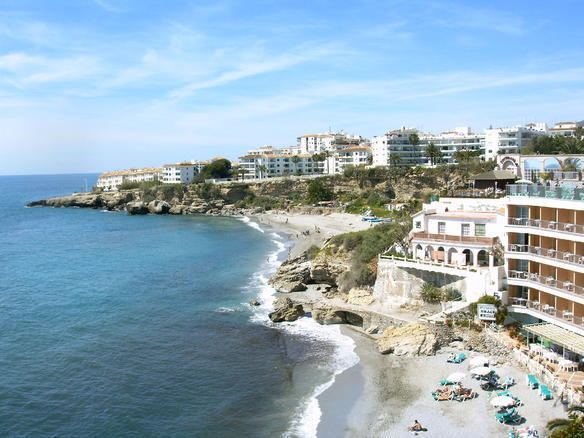Demonym(s) Nerjeños Population 20,649 (2014) | Elevation 26 m (85 ft) Local time Friday 1:56 PM | |
 | ||
Weather 12°C, Wind S at 14 km/h, 64% Humidity Points of interest Caves of Nerja, Beach Cantarriján, Museo de Nerja, Nerja Playa Burriana, El Acueducto del Águila | ||
Nerja com promotional video
Nerja ([ˈneɾχa]) is a municipality on the Costa del Sol in the province of Málaga in the autonomous community of Andalusia in southern Spain. It belongs to the comarca of La Axarquía. It is on the country's southern Mediterranean coast, about 50 km east of Málaga.
Contents
- Nerja com promotional video
- Map of Nerja MC3A1laga Spain
- Wish you were here nerja spain
- History
- Main sights
- Public transport
- Twin towns
- References
Map of Nerja, M%C3%A1laga, Spain
Under Muslim rule, its name was Narixa, which means "abundant source" and is the origin of the current name.
Wish you were here nerja spain
History
Nerja has a long history, evidenced by the primitive paintings found in its famous Nerja caves, discovered in 1959. These caves are now believed to be just one entrance to a linked series of potholes stretching many miles into the mountains between Nerja and Granada, and which may yet prove to be one of the most extensive unexplored systems in Europe. Visitors to the caves will be able to view the remains of one of the ancient inhabitants of Nerja.
The Romans built here three settlements, including Detunda, of which now large remains can be seen. The area was later taken over by the Arabs in the early 8th century. Under the Moors, the town was known as Narixa, which means "abundant spring", from which the present name derives.
Its agricultural and silk products are said to have been famed throughout the Muslim world and in the markets of Damascus as early as the 10th century.
The Balcón de Europa, a mirador or viewpoint which gives stunning views across the sea, is in the centre of the old town. Its name is popularly believed to have been coined by King Alfonso XII, who visited the area in 1885 following a disastrous earthquake and was captivated by the scene. Local folklore says that he stood upon the site where the Balcón now stands, and said "This is the balcony of Europe". Local archive documents are said to show that its name predated this visit, but this has not prevented the authorities from placing a life-sized (and much photographed) statue of the king standing by the railing.
The Balcón area was originally known as La Batería, a reference to the gun battery which existed there in a fortified tower. This emplacement and a similar tower nearby were destroyed during the Peninsular War. In May 1812, the British vessels Hyacinth, Termagant and Basilisk supported Spanish guerrillas on the coast of Granada, against the French. On 20 May, Termagant or Hyacinth opened fire and the forts were destroyed. Two rusty guns positioned at the end of the Balcón are reminders of these violent times. The huge lumps of rock, the remains of La Batería, visible in the sea at the end of the Balcón, are further evidence of this action.
Main sights
Public transport
Nerja is not integrated in the Málaga Metropolitan Transport Consortium.
As well as two local bus routes, around town (from the Riú Mónica Hotel), there are buses from the top of the High Street by the Alsa ticket office to Málaga, Caves of Nerja, Frigiliana, Maro, Almuñécar, Vélez-Málaga, Torre del Mar, Granada, Córdoba, Seville, Almería and Motril.
